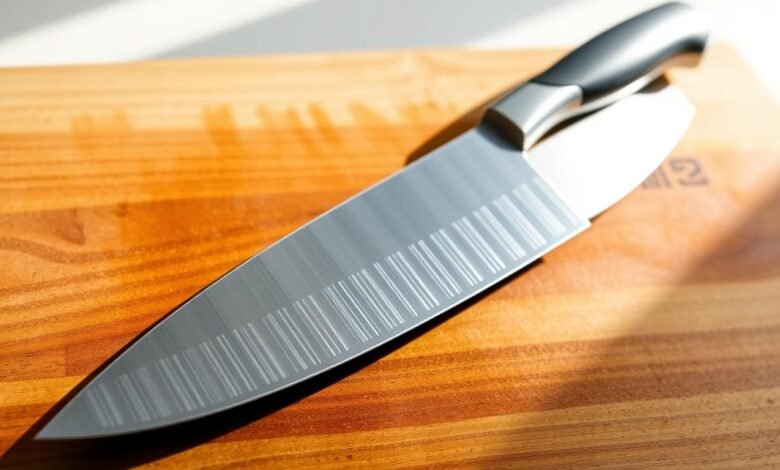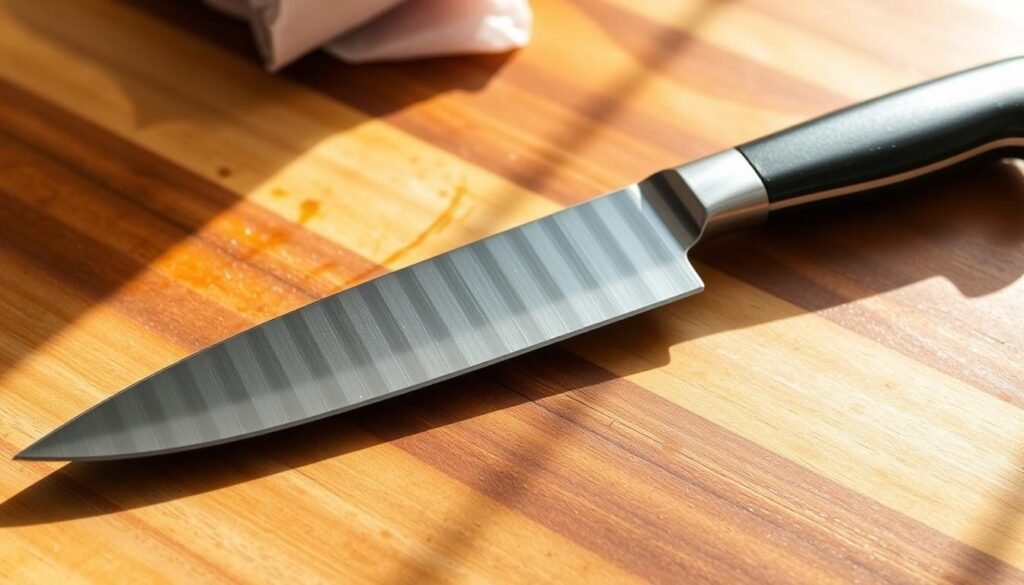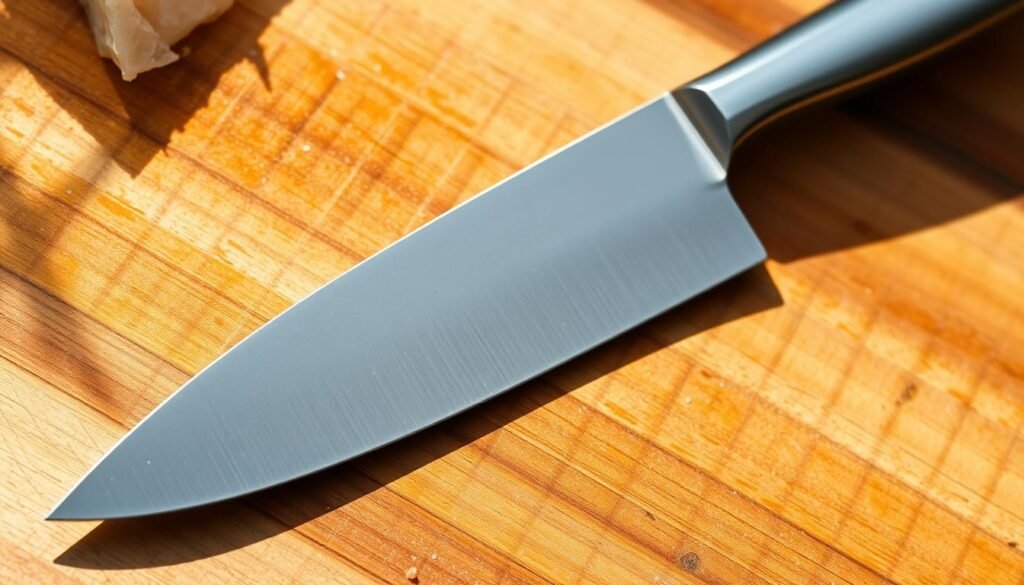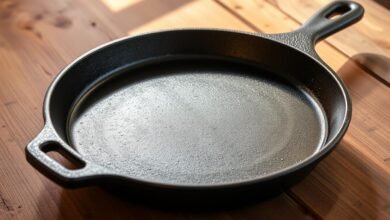
You remember the first time you tried to prepare a fresh catch and felt unsure—wanting a tool that does the job without wasted effort.
This guide puts you first. You’ll learn how purpose-built tools transform whole fish into clean portions fast. We highlight trusted brands, like SORD bundles, WÜSTHOF’s 14.5° per side edge, and Kuda’s corrosion-resistant G4116 steel with ergonomic grips.
Choosing the right fillet knife saves you time and keeps texture and flavor intact. Expect clear measures of quality: steel type, corrosion resistance, flex profile, and edge geometry.
Along the way you’ll compare real products and bundles so you can pick the best fit for your prep style. We focus on what matters to you as a customer and link to shop-ready options on our website.
Key Takeaways
- Purpose-built tools outperform general kitchen options for precision work.
- Look for corrosion-resistant steel and the correct flex for your target species.
- A 14.5° per side edge is a proven benchmark for control and clean cuts.
- Consider bundles that include sheaths and sharpeners to save time.
- Compare products by length, flex, and accessories to find the right match.
Shop Fish Fillet Knives Built for Precision and Control
Find precision tools that match your technique and make every cut predictable.
Shop by length to match species and task. Start with a 6 inch or 7 inch option for panfish and trout, and move to 8″ or 9″ blades for larger targets and long spine pulls.
Choose flexibility that fits your style: super flex for delicate contours, medium flex for balanced control, or traditional flexible models for versatile trimming. SORD Fishing lists 6″, 7″, 8″, and 9″ models plus a 9″ serrated blade. Bundles like the Snapper ($269.99), Tuna ($274.99), and Salmon ($279.99) bundle selections to cover common techniques.
All-in-one sets, such as Kuda’s kit, include 5″ and 7″ flexible blades, a 9″ boning/steaking blade, a 9″ serrated blade, sheaths, and a sharpener. Look for G4116 stainless with anti-corrosion coating and full tang construction for durability and edge retention.
- Compare blades by length, flexibility, and accessories on our website before you add items to your cart.
- Prioritize grip and ergonomics so the tool stays planted during fast work.
- Pick bundles if you want a ready station without hunting for parts.
| Length | Use | Example |
|---|---|---|
| 6″–7″ | Panfish, trout | SORD 6″ Flexy |
| 8″–9″ | Large species, long pulls | SORD 9″ Medium Flex / Kuda set |
| 9″ Serrated | Utility/skin cutting | SORD 9″ Serrated |
What Sets a Quality Fillet Knife Apart

A top-performing tool combines the right steel, a predictable flex, and an edge that tracks cleanly along bone.
Blade steel and finish. Prioritize G4116 stainless with an anti-corrosion coating. This steel resists pitting during wet prep and keeps a keen edge that follows the rib cage precisely.
Flexibility options
Flex profiles matter. Super flex maximizes contact on delicate flesh and helps you trace tight contours. Medium flex gives balanced control for general work. Traditional flexible fillet designs remain versatile for everyday trimming.
Lengths for every task
Pick length by species and stroke. A 5 inch or 6″ model fits small targets and tight cuts. Use 7″, 8″, or 9″ blades for longer, cleaner strokes on larger sides.
Straight-edge vs serrated
Straight-edge blades excel at smooth, decisive slices through flesh and along skin. Serrated options are niche tools for crusted scales or tougher exteriors, but they shouldn’t replace your primary straight-edge.
- Handle & construction: Full tang with ergonomic, textured grips keeps the tool stable and responsive.
- Edge geometry: A 14.5° per side profile is a benchmark for razor-like control.
- Care: Nylon sheaths and corrosion-resistant finishes extend service life in fishing environments.
| Feature | Benefit | Example |
|---|---|---|
| G4116 stainless | Corrosion resistance and edge retention | Kuda set with anti-corrosion coating |
| Flex profiles | Task-matched control for delicate to heavy work | SORD Flexy / Medium / Super Flex |
| Edge geometry | Clean glide and precise cuts | WÜSTHOF 14.5° per side reference |
How to Choose the Right Knife for Your Fish and Fillets
Pick a blade that suits the species you catch most often to keep each pass precise and efficient.
Match blade length to species
Size matters. Choose 5–6″ for panfish and small trout, 7″ for everyday versatility, and 8–9″ for long strokes on salmon and larger sides.
Longer blades reduce the number of passes on big targets and save time. Short blades let you work cleanly around small bones and tight areas.
Select the right flexibility
Super flex conforms to delicate flesh and prevents gouging. Medium flex gives better feedback when you meet bones. For mixed catches, pair a flexible fillet with a stiffer companion so you can adapt on the fly.
Also evaluate how the handle fits in your hand. Textured, secure grips cut down fatigue and slipping during longer sessions.
- Task-based tip: use thin, flexible profiles for boning near the spine and slightly stiffer blades for trimming rib bones.
- Build a set: a two-knife pairing covers both nimble trimming and fast, straight pulls.
- Quality cues: full tang construction and anti-corrosion finishes mean the tool holds up through routine cleaning.
| Blade Length | Best Use | Suggested Option |
|---|---|---|
| 5″–6″ | Panfish, small trout | Short flex model |
| 7″ | All-around | Balanced medium flex |
| 8″–9″ | Salmon, large sides | Long sweep blade |
Fish fillet knife: how to use it for clean, fast results

Start methodically and you’ll turn whole sides into cooking-ready portions with fewer mistakes.
Step-by-step process from tail to head.
- Rinse under cold water and pat dry so your fillet knife tracks without slipping.
- Secure the tail, place the tip at the base, and make a small incision. Glide along the backbone toward the head with even pressure.
- Follow the rib bones using gentle flex and let your hand guide the spine so the edge rides the bone without digging in.
- Lift the first fillet at the shoulder, sweep to release connective tissue, then repeat the same run on the other side.
Sharpness and angle. Aim for about a 14.5° per side angle on your blade. That fine edge gives surgical sharpness for clean cuts and reduced tearing.
Skinning, boning, and control. For skin removal, lay the fillet skin-side down, pinch near the tail, and angle shallow to separate skin in one smooth pull. Trim remaining bones and dark meat with slow, deliberate strokes. Keep your non-dominant hand clear and stabilizing so each cutting pass stays safe and precise.
| Task | Tip | Why it helps |
|---|---|---|
| Rinse & dry | Cold water, pat dry | Prevents slipping and improves tracking |
| Primary cut | Long, even strokes | Maximizes yield and minimizes tears |
| Edge care | Maintain 14.5° per side | Consistent angle keeps slices clean |
Gear up: kits, sheaths, sharpeners, and fishing add-ons
A compact kit can turn a messy prep session into a tidy, efficient workflow.
All-in-one sets let you cover trimming, boning, and utility cuts without hunting for extras. The Kuda Fishing Fillet Knife Set uses G4116 stainless with an anti-corrosion coating and full tang construction. It includes 5″ and 7″ flexible models, a 9″ stout boning/steaking blade, a 9″ serrated utility blade, and a dedicated sharpener.
All-in-one sets with boning and serrated blades plus nylon sheaths
Protective nylon sheaths with belt loops keep each tool secure on the move and shield the edge between tasks. Bundles from Kuda and SORD group multiple products so you get sheaths, a sharpener, and matched grips in one purchase.
Care and maintenance: keep your edge sharp and protected
Rinse and dry after use, then sheath each blade. The included sharpener restores a crisp edge in minutes, saving you time and extending service life.
- Grip & build: look for ergonomic, textured grips so the tool stays planted in your hand during wet work.
- Field kit: carry one flexible blade, a boning profile, and a pocket sharpener for immediate breakdown and transport.
- Value: compare bundles to individual items — sets often save money and include essential sheath and maintenance gear.
| Item | Included | Benefit |
|---|---|---|
| Kuda Set | 5″,7″ flex; 9″ boning; 9″ serrated; sharpener; sheaths | All-purpose coverage with anti-corrosion G4116 |
| SORD bundles | Individual fillet options, 9″ serrated | Pick specific lengths and flex profiles |
| Field kit | One flex blade, boning blade, pocket sharpener | Fast breakdown and easy transport |
Add to cart with confidence: bundles, sizes, and pro-grade features
Add a matched set to your cart and skip the guesswork when you need the right tool for any cut.
Compare pro-ready bundles that group sizes, flex profiles, and accessories so you can buy once and be fully outfitted. SORD bundles list Snapper ($269.99), Tuna ($274.99), and Salmon ($279.99) with 6″, 7″, 8″, and 9″ options plus a 9″ serrated blade.
Consider Kuda’s kit if you want full coverage. It includes 5″ and 7″ flexible models, a 9″ boning/steaking blade, a 9″ serrated tool, nylon sheaths, and a sharpener. The set uses G4116 stainless with an anti-corrosion coating and full tang build.
- Mix sizes: pair a 7″ and a 9″ to handle small portions and long pulls on salmon without switching gear.
- Look for quality cues: full tang, secure sheaths, and ergonomic grips that protect your hand and reduce fatigue.
- Save time: sets with maintenance tools keep edges ready and cut downtime on sharpening.
| Bundle | Key items | Why it helps you |
|---|---|---|
| SORD Snapper / Tuna / Salmon | 6″–9″ options, Flexy/Medium/Super Flex, 9″ serrated | Pick sizes and flex to match target species and prep style |
| Kuda Kit | 5″,7″ flex; 9″ boning; 9″ serrated; sheaths; sharpener | All-purpose set with anti-corrosion G4116 and full tang |
| Field set | One flexible blade, one medium, pocket sharpener | Compact, versatile, ideal for on-the-go customers |
Conclusion
The right combination of steel, edge, and grip turns a slow session into a quick, precise one.
strong, Prioritize proven construction: G4116 stainless with an anti-corrosion coating, full tang builds, and ergonomic dual-molded grips. These choices keep a fine edge and reduce wear during regular use.
Pair a short precision blade with a longer companion so you cover trimming and long, fluid strokes along a salmon side. Store each tool in a nylon sheath and perform quick touch-ups to keep cuts neat and minimize leftover bones or wasted meat.
Work methodically, stabilize the catch with your free hand, and let the blade do the cutting. Shop with confidence: compare specs, pick the kit that matches your routine, and you’ll be ready for your next catch or weeknight meal as a satisfied customer.

